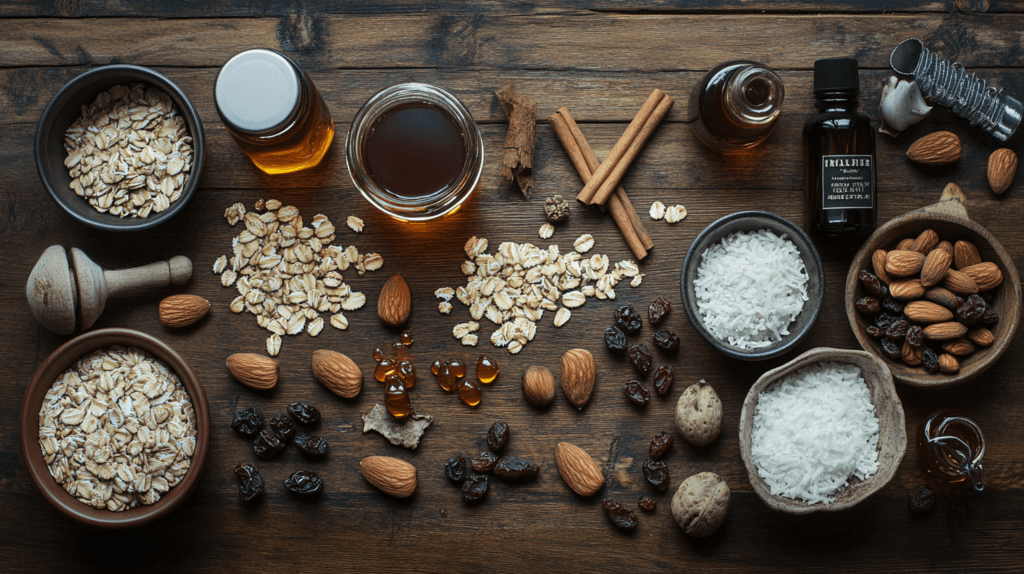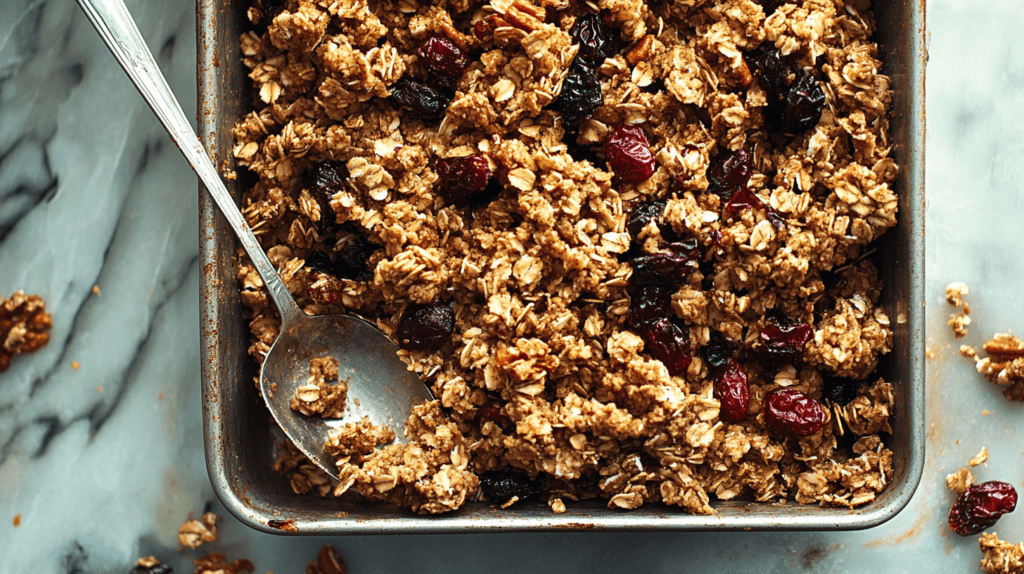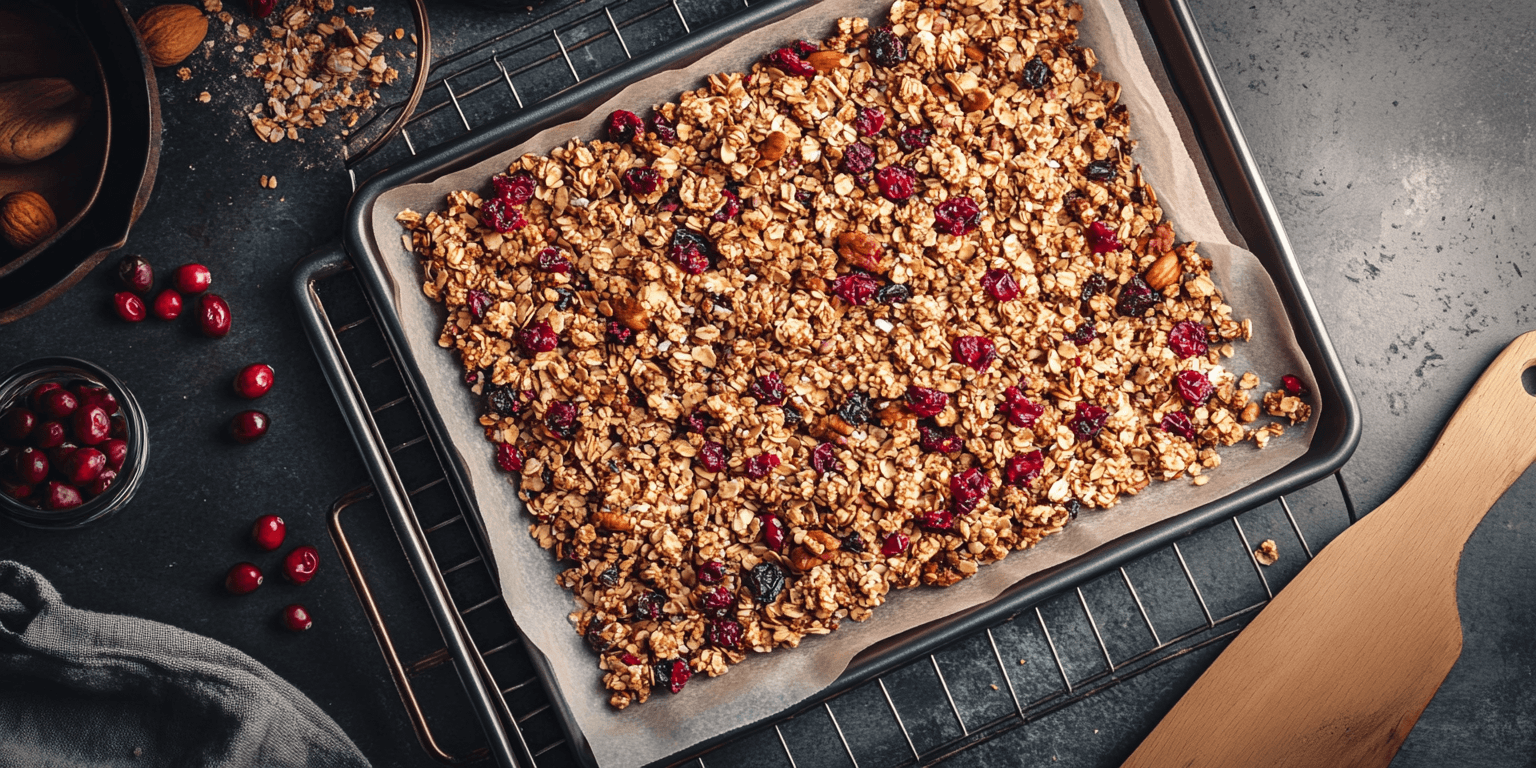Last updated on April 26th, 2025
Homemade granola is a versatile and healthier alternative to store bought options. A personalized granola recipe offers a perfect balance of crunchy textures, wholesome ingredients, and customizable flavors. Unlike commercial versions, which often contain excess sugar and preservatives, making granola at home gives you full control over ingredients, allowing you to create a nutrient packed breakfast, a yogurt topper, or an easy snack.
Granola is a mix of rolled oats, nuts, sweeteners, and oils, baked to golden perfection. Its appeal lies in its adaptability, catering to diverse tastes with sweet, chewy, or even savory variations. Use it as a cereal, bake it into cookies, or add it to savory dishes for texture. For more inspiration, explore our baked bean recipe, showcasing the versatility of homemade staples.
Table of Contents
Why Make Your Own Granola Recipe?
Making your own granola offers a wealth of benefits that go beyond flavor. A homemade granola recipe puts you in full control of ingredients, ensuring that every bite aligns with your dietary goals and taste preferences.
1. Healthier Ingredients
Homemade granola eliminates the hidden sugars and preservatives commonly found in store bought options. By creating your own granola recipe, you can use natural sweeteners like honey, agave, or maple syrup and incorporate heart healthy oils like coconut or olive oil. For more ideas on creating nutrient rich meals, explore our banana bread muffin recipe, which highlights wholesome ingredient swaps for classic recipes.
2. Customizable to Your Preferences
No two granola recipes need to be the same. Whether you prefer the crunch of roasted almonds, the sweetness of dried cranberries, or the decadence of dark chocolate chips, your homemade granola can reflect your unique taste. Consider experimenting with seasonal flavors like pumpkin spice or citrus zest to keep your granola exciting year round. For more tips on seasonal cooking, visit our Ultimate Guide to Low Carb Food.
3. Cost Effective
Premium granola brands can be expensive, but a homemade granola recipe is budget friendly. By buying ingredients like oats, nuts, and seeds in bulk, you can create high quality granola at a fraction of the price. For inspiration on other cost effective meals, check out our baked bean recipe, which highlights affordable, hearty ingredients.
4. Environmentally Friendly
Reducing packaging waste is another great reason to try a homemade granola recipe. By storing your granola in reusable containers, you contribute to a more sustainable kitchen. If you’re interested in further reducing waste, our easy orange chicken recipe provides practical tips for eco conscious cooking.
5. A Fun and Rewarding Experience
Creating a personalized granola recipe is not just practical it’s enjoyable. The process of mixing ingredients, choosing flavors, and baking the granola to golden perfection can be a fun and satisfying project for individuals or families. Pair this experience with another homemade treat, like our banana bread muffins, to make your kitchen a hub of creativity.
With these benefits in mind, it’s clear why so many people are turning to homemade granola recipes. Ready to get started? Check out our tips on storage and preparation in the following sections to ensure your granola stays fresh and flavorful.
Ingredients for the Perfect Granola Recipe

Base Ingredients
- Rolled Oats: A nutritious foundation for your granola.
- Sweeteners: Honey, maple syrup, or brown sugar for caramelization.
- Oil: Coconut or olive oil ensures even toasting and adds richness.
Optional Add Ins
- Nuts and Seeds: Almonds, pecans, pumpkin seeds, or flaxseeds.
- Dried Fruits: Raisins, cranberries, or apricots for sweetness.
- Extras: Shredded coconut, chocolate chips, or spices like cinnamon.
To learn how ingredient substitutions can affect your recipe’s nutritional profile, check out the Ultimate Guide to Low Carb Food.
Step by Step: How to Make Granola
1. Mix the Ingredients
Combine 3 cups of rolled oats, 1 cup of chopped nuts or seeds, and a pinch of salt in a large mixing bowl.
2. Prepare the Liquid Mix
Whisk together ⅓ cup of oil, ⅓ cup of maple syrup or honey, and 1 teaspoon of vanilla extract.
3. Combine and Spread
Pour the liquid mix over the dry ingredients and stir until fully coated. Spread evenly on a baking sheet lined with parchment paper.
4. Bake and Stir
Bake at 300°F (150°C) for 20–30 minutes, stirring halfway through for even toasting.
5. Add Dried Fruits After Baking
Once cooled, mix in dried fruits or chocolate chips for a flavorful finish.
Variations for Your Granola Recipe
Sweet Granola
- Use vanilla, cinnamon, or chocolate chips for dessert inspired flavors.
Savory Granola
- Add smoked paprika, cumin, or chili flakes for a unique, savory twist.
Seasonal Granola
- Incorporate pumpkin puree and spices for autumn or dried cranberries and citrus zest for a festive winter blend.

Storing Homemade Granola
Proper storage is key to preserving the crunch and flavor of your granola:
- Use airtight containers like mason jars or resealable bags.
- Store in a cool, dry place for up to two weeks.
- For extended shelf life, freeze in sealed containers.
If you’re interested in exploring similar storage tips for other homemade foods, check out the Easy Orange Chicken Recipe for practical advice.
Frequently Asked Questions About Granola Recipe
Making the perfect granola recipe can be a rewarding experience, but it often raises some questions. Here, we provide detailed answers to help you achieve crunchy, delicious, and perfectly balanced granola every time. Whether you’re new to making granola or looking to refine your technique, these insights will set you up for success.
Why is my homemade granola not crunchy?
A lack of crunch in your granola recipe can result from a few factors:
- Temperature Issues: Baking granola at too low a temperature can prevent the oats and nuts from toasting properly. Always bake your granola at 300°F (150°C) for even toasting.
- Moisture Content: If you add dried fruits or fresh ingredients before baking, they can introduce moisture, making it harder for the granola to crisp up. Add dried fruits only after the granola has fully cooled.
- Improper Cooling: Letting your granola cool completely on the baking sheet helps it firm up and achieve its signature crunch. Moving it too soon can cause it to lose texture.
For additional tips on mastering textures in your granola recipe, explore our guide on The Ultimate Guide to Low Carb Food, which offers valuable insights into ingredient preparation.
Why add baking soda to granola?
Adding baking soda to a granola recipe is not common but can be used to create a lighter texture in some variations. When combined with acidic ingredients like honey or maple syrup, baking soda produces carbon dioxide, introducing air pockets into the mixture. This technique is particularly useful if you want a granola that’s less dense and slightly airy. However, baking soda is typically optional and may not be needed in traditional granola recipes.
If you’re experimenting with new techniques for your granola, consider pairing it with recipes like our Baked Bean Recipe for a wholesome, homemade meal idea.
What makes granola clump together?
The clumps in your granola recipe are often the most sought after part, and achieving them requires the right technique:
- Binding Ingredients: Sweeteners like honey or maple syrup and fats like coconut oil act as binders, helping the oats and mix ins stick together.
- Minimal Stirring: Stirring too much during baking can break apart potential clusters. If you want clumps, stir only once or twice while baking.
- Egg Whites: Whisked egg whites added to your granola mix can act as a glue, encouraging large, crunchy clusters.
For more tips on achieving texture perfection, visit our Easy Orange Chicken Recipe to learn how different cooking techniques can enhance the overall dish.
What makes granola so high in calories?
Granola is nutrient dense, which can lead to a higher calorie count. Here are the main culprits in a granola recipe:
- Nuts and Seeds: While rich in healthy fats and protein, nuts and seeds are calorie dense. Use them in moderation if you’re watching your calorie intake.
- Sweeteners: Honey, maple syrup, and brown sugar contribute to the sweetness and calorie count. Consider using less or substituting with low calorie options.
- Oil: Oils like coconut or olive oil add richness but can also increase calories. Opt for lighter oils or reduce the amount slightly.
To create a lower calorie granola recipe, explore substitutions in our Ultimate Guide to Low Carb Food, which provides excellent tips for maintaining flavor while cutting calories.
How do I keep granola crunchy?
To maintain the crunch in your granola recipe, follow these steps:
- Store granola in an airtight container to prevent exposure to moisture.
- Ensure the granola is completely cooled before transferring it to storage.
- For extended freshness, freeze granola in a resealable bag and thaw small portions as needed.
What are the healthiest mix ins for granola?
Healthy mix ins can boost the nutritional profile of your granola recipe:
- Seeds: Chia, flax, and hemp seeds provide omega 3s and fiber.
- Unsweetened Dried Fruits: Options like raisins or apricots add natural sweetness without added sugars.
- Spices: Cinnamon and nutmeg enhance flavor without calories.
For more ideas on healthy mix ins and substitutions, visit our Banana Bread Muffin Recipe, which highlights nutritious additions to baked goods.
Can granola fit into a low carb diet?
Granola can be adapted for a low carb diet by:
- Substituting rolled oats with low carb alternatives like unsweetened coconut flakes or nuts.
- Using sugar free sweeteners like erythritol or monk fruit.
- Adding high fat, low carb ingredients like flaxseeds or macadamia nuts.
For inspiration on crafting a low carb granola recipe, check out our Ultimate Guide to Low Carb Food.
Conclusion: Crafting the Perfect Granola Recipe
Creating a homemade granola recipe is not just about making a delicious snack it’s about crafting something tailored to your tastes and dietary preferences. With simple, wholesome ingredients and the flexibility to experiment with flavors, granola becomes more than a pantry staple. Whether you prefer clusters, crunch, or bold flavors, this versatile dish has endless possibilities.
Homemade granola offers health benefits, cost savings, and an eco friendly approach to snacking. As you experiment with ingredients and techniques, you’ll discover that making granola at home is both rewarding and fun. Start with your favorite base ingredients, get creative with mix ins, and enjoy the satisfaction of a perfectly baked batch.

Healthy Granola
Equipment
- Mixing Bowl
- Whisk
- Baking Sheet
- Parchment Paper
- Spatula
Ingredients
Main Ingredients
- 4 cups old-fashioned rolled oats certified gluten-free if needed
- 1.5 cups nuts and/or seeds such as pecans, almonds, pepitas
- 1/2 teaspoon fine-grain sea salt
- 1/2 teaspoon ground cinnamon
- 1/2 cup melted coconut oil or olive oil
- 1/2 cup maple syrup or honey
- 1 teaspoon vanilla extract
Optional Add-ins
- 2/3 cup dried fruit such as cranberries, cherries, raisins
Instructions
- Preheat the oven to 350°F (175°C) and line a large, rimmed baking sheet with parchment paper.
- In a large bowl, combine oats, nuts, salt, and cinnamon. Stir to blend.
- Pour in the oil, maple syrup (or honey), and vanilla. Mix well to coat.
- Spread the granola evenly onto the prepared baking sheet. Bake until lightly golden, about 20–24 minutes, stirring halfway.
- Let the granola cool completely on the baking sheet. It will crisp up as it cools.
- Stir in dried fruit once cooled, if using. Store in an airtight container at room temperature for 1–2 weeks, or freeze for longer storage.
Notes
Granola isn’t just delicious; it’s also a great opportunity to boost your daily fiber intake and heart health. For science-backed insights on whole grains and healthy eating, check out the Harvard T.H. Chan School of Public Health’s Nutrition Source. Their guide dives deep into why ingredients like oats and nuts are a smart choice.

